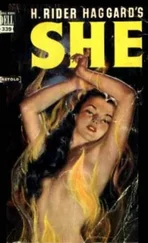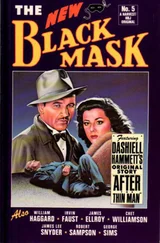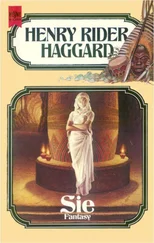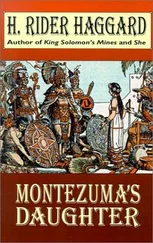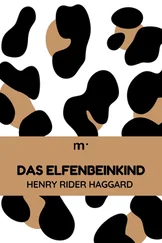1 ...6 7 8 10 11 12 ...17 The English translation was, as I discovered on further investigation, and as the reader may easily see by comparison, both accurate and elegant.
Besides the uncial writing on the convex side of the sherd at the top, painted in dull red, on what had once been the lip of the amphora, was the cartouche already mentioned as being on the scarabæus, which we had also found in the casket. The hieroglyphics or symbols, however, were reversed, just as though they had been pressed on wax. Whether this was the cartouche of the original Kallikrates, [2]or of some Prince or Pharaoh from whom his wife Amenartas was descended, I am not sure, nor can I tell if it was drawn upon the sherd at the same time that the uncial Greek was inscribed, or copied on more recently from the Scarab by some other member of the family. Nor was this all. At the foot of the writing, painted in the same dull red, was the faint outline of a somewhat rude drawing of the head and shoulders of a Sphinx wearing two feathers, symbols of majesty, which, though common enough upon the effigies of sacred bulls and gods, I have never before met with on a Sphinx.
[2] The cartouche, if it be a true cartouche, cannot have been that of Kallikrates, as Mr. Holly suggests. Kallikrates was a priest and not entitled to a cartouche, which was the prerogative of Egyptian royalty, though he might have inscribed his name or title upon an oval.—Editor.
Also on the right-hand side of this surface of the sherd, painted obliquely in red on the space not covered by the uncial characters, and signed in blue paint, was the following quaint inscription:—
IN EARTH AND SKIE AND SEA
STRANGE THYNGES THER BE.
HOC FECIT
DOROTHEA VINCEY.
Perfectly bewildered, I turned the relic over. It was covered from top to bottom with notes and signatures in Greek, Latin, and English. The first in uncial Greek was by Tisisthenes, the son to whom the writing was addressed. It was, “I could not go. Tisisthenes to his son, Kallikrates.” Here it is in fac-simile with its cursive equivalent:—
ΟΥΚΑΝΔΥΝΑΙΜΗΝΠΟΡΕΥΕϹΘΑΙΤΙϹΙϹΘΕΝΗϹΚΑΛΛΙΚΡΑΤΕΙΤΩΙΠΑΙΔΙ
οὐκ ἂν δυναίμην πορεύεσθαι. Τισισθένης Καλλικράτει τῷ παιδί.
This Kallikrates (probably, in the Greek fashion, so named after his grandfather) evidently made some attempt to start on the quest, for his entry written in very faint and almost illegible uncial is, “I ceased from my going, the gods being against me. Kallikrates to his son.” Here it is also:—
ΤΩΝΘΕΩΝΑΝΤΙΣΤΑΝΤΩΝΕΠΑΥΣΑΜΗΝΤΗΣΠΟΡΕΙΑΣΑΛΛΙΚΡΑΤΗΣΤΩΙΠΑΙΔΙ
τῶν θεῶν ἀντιστάντων ἐπαυσάμην τῆς πορείας. Καλλικράτης τῷ παιδί.
Between these two ancient writings, the second of which was inscribed upside down and was so faint and worn that, had it not been for the transcript of it executed by Vincey, I should scarcely have been able to read it, since, owing to its having been written on that portion of the tile which had, in the course of ages, undergone the most handling, it was nearly rubbed out—was the bold, modern-looking signature of one Lionel Vincey, “Ætate sua 17,” which was written thereon, I think, by Leo’s grandfather. To the right of this were the initials “J. B. V.,” and below came a variety of Greek signatures, in uncial and cursive character, and what appeared to be some carelessly executed repetitions of the sentence τῷ παιδί (to my son), showing that the relic was religiously passed on from generation to generation.
The next legible thing after the Greek signatures was the word “Romae, A.U.C.,” showing that the family had now migrated to Rome. Unfortunately, however, with the exception of its termination (evi) the date of their settlement there is for ever lost, for just where it had been placed a piece of the potsherd is broken away.
Then followed twelve Latin signatures, jotted about here and there, wherever there was a space upon the tile suitable to their inscription. These signatures, with three exceptions only, ended with the name “Vindex” or “the Avenger,” which seems to have been adopted by the family after its migration to Rome as a kind of equivalent to the Greek “Tisisthenes,” which also means an avenger. Ultimately, as might be expected, this Latin cognomen of Vindex was transformed first into De Vincey, and then into the plain, modern Vincey. It is very curious to observe how the idea of revenge, inspired by an Egyptian who lived before the time of Christ, is thus, as it were, embalmed in an English family name.
A few of the Roman names inscribed upon the sherd I have actually since found mentioned in history and other records. They were, if I remember right,
MVSSIVS. VINDEX
SEX. VARIVS MARVLLVS
C. FVFIDIVS. C. F. VINDEX
and
LABERIA POMPEIANA. CONIVX. MACRINI. VINDICIS
this last being, of course, the name of a Roman lady.
The following list, however, comprises all the Latin names upon the sherd:—
C. CAECILIVS VINDEX
M. AIMILIVS VINDEX
SEX. VARIVS. MARVLLVS
Q. SOSIVS PRISCVS SENECIO VINDEX
L. VALERIVS COMINIVS VINDEX
SEX. OTACILIVS. M. F.
L. ATTIVS. VINDEX
MVSSIVS VINDEX
C. FVFIDIVS. C. F. VINDEX
LICINIVS FAVSTVS
LABERIA POMPEIANA CONIVX MACRINI VINDICIS
MANILIA LVCILLA CONIVX MARVLLI VINDICIS
After the Roman names there is evidently a gap of very many centuries. Nobody will ever know now what was the history of the relic during those dark ages, or how it came to have been preserved in the family. My poor friend Vincey had, it will be remembered, told me that his Roman ancestors finally settled in Lombardy, and when Charlemagne invaded it, returned with him across the Alps, and made their home in Brittany, whence they crossed to England in the reign of Edward the Confessor. How he knew this I am not aware, for there is no reference to Lombardy or Charlemagne upon the tile, though, as will presently be seen, there is a reference to Brittany. To continue: the next entries on the sherd, if I may except a long splash either of blood or red colouring matter of some sort, consist of two crosses drawn in red pigment, and probably representing Crusaders’ swords, and a rather neat monogram (“D. V.”) in scarlet and blue, perhaps executed by that same Dorothea Vincey who wrote, or rather painted, the doggrel couplet. To the left of this, inscribed in faint blue, were the initials A. V., and after them a date, 1800.
Then came what was perhaps as curious an entry as anything upon this extraordinary relic of the past. It is executed in black letter, written over the crosses or Crusaders’ swords, and dated fourteen hundred and forty-five. As the best plan will be to allow it to speak for itself, I here give the black-letter fac-simile, together with the original Latin without the contractions, from which it will be seen that the writer was a fair mediæval Latinist. Also we discovered what is still more curious, an English version of the black-letter Latin. This, also written in black letter, we found inscribed on a second parchment that was in the coffer, apparently somewhat older in date than that on which was inscribed the mediæval Latin translation of the uncial Greek of which I shall speak presently. This I also give in full.
Fac-simile of Black-Letter Inscription on the Sherd of Amenartas.
“Iſta reliq̅ia eſt valde miſticu̅ et myrificu̅ op̅s q̅d maiores mei ex Armorica ſſ Brittania mi̅ore ſecu̅ co̅veheba̅t et q̅dm ſc̅s cleric̅s ſe̅per p̅ri meo in manu ferebat q̅d pe̅itus illvd deſtrueret, affirma̅s q̅d eſſet ab ipſo ſathana co̅flatu̅ preſtigioſa et dyabolica arte q̅re p̅ter mevs co̅fregit illvd i̅ dvas p̅tes q̅s q̅dm ego Johs̅ de Vi̅ceto ſalvas ſervavi et adaptavi ſicut ap̅paret die lu̅e p̅r̅ poſt feſt beate Mrie vir{g} anni gr̅e mccccxlv.”
Читать дальше

